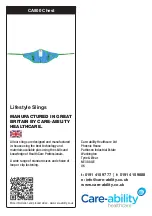
When placing two (or more) one-legged slings directly on the hook (without assembling
links) the maximum angle of the slings is 45°. As the angle of inclination increases, the
load of each leg increases as well, e.g. with the angle β=20o the load capacity
of the
sling is 94% of the sling's rated capacity (0.94 load weight). With angle β=45o the load
capacity of the sling is 71% of the rated capacity of the sling (0.707 load weight). At an
angle of β=60o the load capacity of the sling is 50% of the rated loa
d capacity (0.5 load
weight).
3.5.
Inspections of slings
INITIAL INSPECTION
It is performed before putting each new or repaired sling to use. It consists in checking
•
the conformity of the sling with the order,
•
whether the sling was damaged during transport,
•
conformity of the markings, including the rating plate,
•
condition of the sling. It is necessary to check if the sling is free from defects,
considerable dirt, and at the same time if it is not qualified to be withdrawn
from use.
RUNNING INSPECTION
It is performed before starting work and on a regular basis, while using the sling. The
current inspection is performed by personnel carrying out the lifting operation. It
consists in visual assessment of the sling in terms of possible damage. In case any
irregularities are found, the sling should be sent for a detailed inspection. In case any
significant damage is found, the sling should be withdrawn from use.
PERIODIC INSPECTION
It is performed at least once every 6 months. The frequency of inspection should be
adjusted to the frequency of using the sling and specific (demanding) conditions in
which the sling is used. Periodic (detailed) inspection is performed by designated,
trained personnel. Documentation should be made during each periodic inspection and
then kept.
3.6.
Cleaning and maintenance
a)
Store the product in a dry and cool place protected from moisture and direct
sunlight.
b)
Perform regular inspections of the product to ensure that it is in good working
order and that any damage has occurred.
DISPOSAL OF USED UNITS.
At the end of its useful life, this product should not be disposed of with normal
household waste but should be taken to a collection point for the recycling of electrical
and electronic equipment. This is indicated by the symbol on the product, operating
instructions or packaging. The materials used in this unit are recyclable according to
Summary of Contents for SBS-HG-10010
Page 41: ......


































